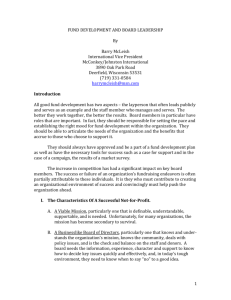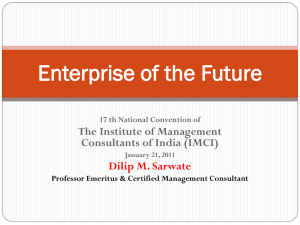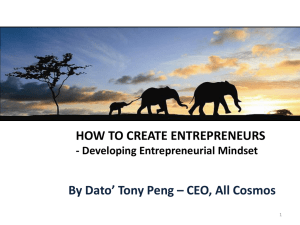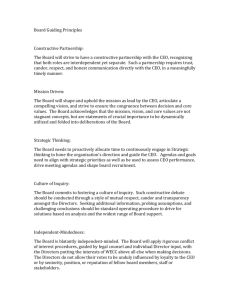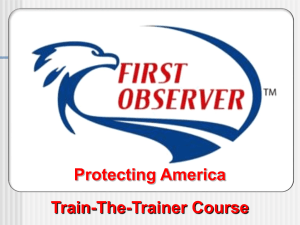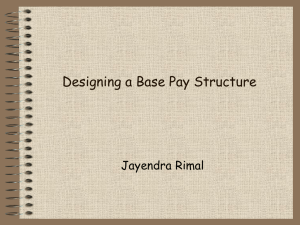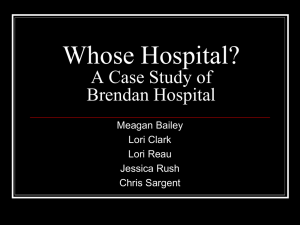Workshop 4 - Presentation
advertisement
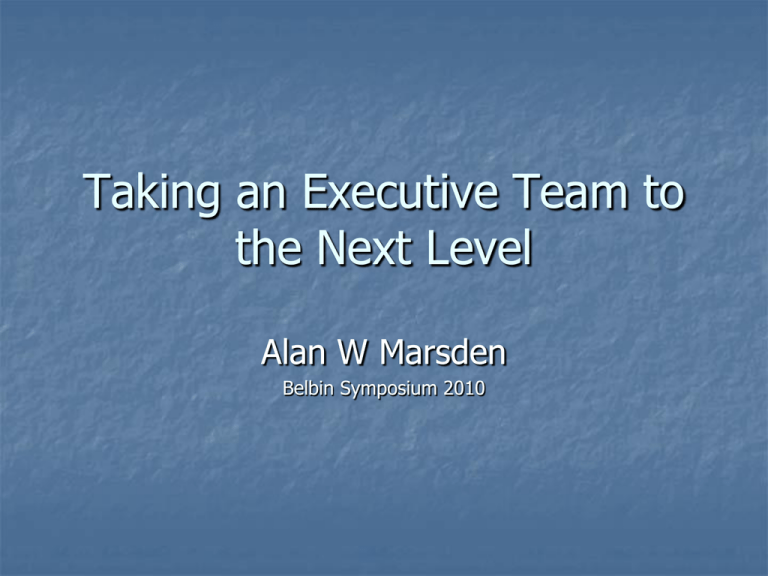
Taking an Executive Team to the Next Level Alan W Marsden Belbin Symposium 2010 The Business One of Europe’s largest Utility companies 13.8 million customers Major project investments (£800m - £1bn pa) 4,600 employees Regulated The Situation 3 year programme of ‘operational improvement’ completed Attention over previous 3 years had centred around functional performance CEO who had taken company through the 3 year programme now gone and new CEO in place Realisation that Executive were not a ‘team’ but a group of ‘individuals’, but Board acknowledgement of their achievements in turning business around Recognition that what was now needed ‘to take business to next level’ was an effective Executive Team The Executive Team Newly appointed CEO CFO COO Regulatory & Strategy D Asset Management D HRD Customer Service D * * Interim appointment It was clear that a somewhat cautious approach to the softer side would be needed BUT….new CEO clearly felt that a High EQ Team was needed if sustainable performance was to be delivered Initial process………… Decided to use Belbin Team Roles – SPI’s and Observer input – but based discussions on EQ Each completes SPI 1:1 Feedback 3 Day Workshop (off-site/residential) Observer Input Everyone quickly bought into Team Roles and the ‘language’ 1 Day STRATEGY Workshop Lack of Trust, Disillusionment & Lack of Respect From next level down From the workshop it was clear that there were major issues between the different Directors and from what had been said between the Directors and their direct reports. Nevertheless – following the workshop it was reported that there had been some improvements The Workshop Needed to be ‘behaviourally’ based, BUT recognising that we were working in an environment that might not be emotionally capable of taking this. Got them to really get into Team Roles and when we felt they were feeling comfortable with this we talked ‘EQ’! To give them a feeling of ‘control’ we then concentrated on the Observer words, asking them to select the words which were positive EQ words, and those that were negative EQ words. Because they had completed Observer input from colleagues and their subordinates we were then able to explore at ‘team’ and at ‘individual’ levels Once we felt comfortable that they were able to take a more direct and behaviourally difficult approach we introduced the “3 HATS” exercise. This really opened everything up…..and even now is referred to as being the catalyst that led to the breakthrough. The next stages………… Follow-up discussions with the CEO (now with a further 2 month’s experience in-situ) showed that he continued to have major concerns with at least 2 of his ‘team’. Because of what we had heard at the workshop we agreed to hold half-day workshops with each ‘Functional’ group of direct reports. These were very carefully structured so as to gather the information we felt we needed. We included using the Observer words for each individual Director. All of the information was then sorted and played back at follow-up ‘cross-functional’ workshops, where the issues and concerns were ‘signed off’ 6 ‘Functional’ workshops Write-up Issues & Concerns 3 ’Cross Function’ Workshops The 1:1 interviews with Directors – 1 recognised he was ‘out of place’, another held cards close to chest but our assessment was that there was recognition here also But……………….. SHOCK!!!! It was now clearly recognised that if progress was to be made these 2 would have to go! The ‘General’ issues, concerns and feedback received were of real concern BUT the Specifics for 2 of the Executive members were of real concern. The CEO wished to know whether or not these 2 individuals could change. Our ‘opinion’ was that 1 just couldn’t whilst the other might but in the longer term (it was hardly likely in anything less than 2 to 3 years. This judgement was made based upon experience, SPI & Observer data (which showed complete misalignment with Team EQ), advice from highly respected academics, and the content of the individual’s issues, concerns and feedback. Furthermore…..we stated that were they to remain in situ the Executive would continue to be dysfunctional. Following discussions between the CEO and the Chairman the appropriate action was taken! And so we moved to the next stage…. Now aware of the ‘shape’ of the team we knew what ‘roles’ and what EQ competencies we needed. The concurrent ‘Strategy’ work had identified a different Organisation Structure and so we were able to help the company with ‘fits’ We then took the NEW team away for a further 2 day workshop. We were now able to adopt a totally ‘behavioural’ approach, which met with incredible success. Amongst the outcomes was the formulation of a Psychological Contract designed by the Exec team, for their interactions and work with their direct reports. This was then taken to the 60 odd direct reports, discussed, amended and signed – by everyone. A copy is held by everyone – there is real belief in it – and the evidence to date is that it works, and that the Executive Team is displaying high level Emotional Intelligence. Perhaps even more importantly (as far as the business is concerned) – they are meeting with commercial success. What next? Our job is to carry out periodic checks to ensure that progress continues If any individual changes are needed then we will help the company ensure that the replacements/new members ‘fit’ – both in respect of team role and EQ (in other words – true suitability) PS: The company has invested in intensive ‘Leadership’ programmes for the senior group (direct reports – 60), and for the next 340. These programmes include a great deal of behavioural awareness



